The Caucasus - flora, vegetation and ethnobotany

Skhara, der höchste Berg Georgiens, in Svaneti.
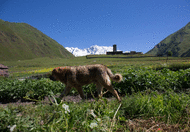
Ein Kaukasischer Schäferhund in Garten vor der Lamaria Kirche in Ushguli, Svanetien verdeutlicht die Jahrtausendalte Tradition in Georgien.
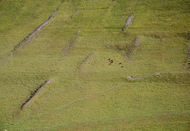
Verlassene Terassenäcker in den bergen Georgiens
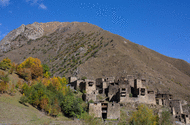
Shatili, ein typisches Dorf in Khevsureti, Georgien
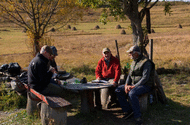
Interview mit lokalen Bauern über traditionelles Pflanzenwissen
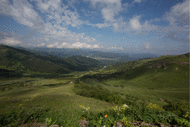
Die Landschaft des Kleinen Kaukasus, mit Dorf Bakuriani und Botanischen Garten im Hintergrund.
The Caucasus - flora, vegetation and ethnobotany
Few regions in Europe are more steeped in mythology than the Caucasus, and few have sparked more interest from botanists and anthropologists alike. Indeed, given the historical, cultural, economic, religious and ethnic diversity of the region, it would be impossible to define the Caucasus in a single term.
The mountain ranges of the Greater and Lesser Caucasus form one of the most important biodiversity hotspots and also a cradle for human crop use, where human agriculture dates back at least 9000 years, with an amazing human diversity. The Greek historian Herodotus wrote in the 5th century BC. that “many and all kinds of nations dwell in the Caucasus,” and Strabo, early in the first century AD, reported 70 “tribes” in the region, each with its own language. The Roman chronicler Pliny the Elder wrote that the Romans needed 130 interpreters to do business in the Caucasus. The language families Armenian and Kartvelian (to which Georgian belongs) are among the oldest in the world.
This incredible diversity and the importance of the region, e.g. as a transit area for the Silk Road, is also reflected in the use of plants, and while many species have been shared in different parts of the Caucasus, humans have also developed a wide range of different plant resources to use, be it as food, medicine or utensils and tools.
The combination of a variety of ecosystems supporting tremendous botanical diversity, together with ancient plant-use practices and the stunning hospitality of its peoples, makes the Caucasus an ethnobotanist's dream destination. While ethnobotanical research in the region was fairly prominent in the early 20th century, little research in the field has been published from the region since the 1940s. Given the lack of recent publications on human plant use in the wider Caucasus, this volume is a very up-to-date compilation of the main wild plant species used in Armenia, Azerbaijan and Sakartvelo (Republic of Georgia).
Ethnobotany in the Georgian Caucasus
The territory of present-day Georgia has been continuously inhabited since the early Stone Age, and agriculture was developed during the early Neolithic period. In Georgian, the country's name is "Sakartvelo", and "Georgia" is semantically related to Greek (γεωργία), meaning "agriculture". However, human occupation began in the early Pleistocene. The 1.7-million-year-old hominid fossils from Dmanisi in South Georgia are the earliest known hominid finds outside of Africa. This specimen has been classified as Late Middle Paleolithic and Early Upper Neanderthal, and modern human habitation is well documented. Upper Paleolithic fossils from Dzudzuana Cave include remains of wool (Capracaucasica) and dyed fibers of wild flax (Linum usitatissimum L.) dated to ~36–34 Ka BP.
The Caucasus is considered one of the global biodiversity hotspots, and Georgia has its fair share of the region's vast diversity. The botanical exploration of the Caucasus has a long history that has resulted in good recent treatments of the area's vegetation, particularly with regard to Georgia. As such, Georgia has long been the center of botanical exploration in the Caucasus, with the Bakuriani Alpine Botanic Garden serving as a hub. The log of visitors to the garden reads like a "Who's Who" of 20th-century botany.
Archaeological finds from the Neolithic and early Bronze Age are rich in plant fossils and seeds of wild species and local landraces. Seven species of cultivated wheat - Triticum aestivum L., T. carthlicum Nevski, T. compactum Host, T. dicoccum Cabinet, T. macha Dekapr. & Menabde, T. monococcum L., T. spelta L., a wild relative, Aegilops cylindrica Host., as well as millet - Panicum milliaceum L., barley - Hordeum vulgare L., Italian millet - Setaria italica L.) P B. Beauv., oats - Avena sativa L., wild lentil - Lens ervoides (Brignolidi & Brunhoff) Grande and pea - Pisum sativum L. were discovered at Arukhlo, dating to the 6th to 2nd millennium BC. The earliest grapevine seeds indicative of cultivation have been unearthed in South Georgia and date to around 8,000 years BC. Due to its long tradition, agriculture in Georgia is characterized by a large variety of landraces and endemic crop species. These show a high adaptability to local climatic conditions and often a high disease resistance. Early research documented this great diversity, but rapid loss of local grains, legumes and flax began in the 1950s with Stalinist agrarian reform. Despite the long cultural history, recent studies on cultivated plants are rather rare.
Georgia is considered one of the oldest Christian regions, adopting Christianity around 320 AD. A great example of early church building is the 14th-century Gergeti Trinity Church, located at 2170 m at the foot of Mount Kazbeghi (5047 m), overlooking the narrow valley that leads from Georgia to Ingushetia. However, ancestral shrines are still very common in many regions of Georgia.
Wine grapes - Vitis vinifera L. (Vitaceae) show genetic diversity in Georgia, with around 500 known varieties, and in most regions the population takes great pride in producing their own wine and sharing it with visitors. There is hardly a house in the Georgian lowlands without at least a few grapes in the garden or backyard. Today, forty-one cultivars of grapevines are used as commercial varieties in Georgia and good wine is readily available, but the history of vine cultivation and winemaking stretches back thousands of years. As in other parts of Europe, Georgian grapes were devastated by phylloxera, and after infestations in the 1860s, most Georgian grape varieties are now grafted onto rootstocks of American grape varieties resistant to phylloxera.
Wheat - Triticum L. (Poaceae): Sixteen species, 144 varieties and 150 forms of wheat were recorded in Georgia in the 1940s (Menabde 1948). However, this diversity has declined sharply and most species had already disappeared by the 1960s, when introduced varieties were favored in Soviet collective farm systems. Currently, none of these species are sown in Georgian commercial agriculture.
Barley – Hordeum vulgare L. (Poaceae) is also an ancient agricultural crop in Georgia and had a special importance in beer production as well as a function in religious rituals and traditional medicine.
Rye - Secale cereale L. (Poaceae) was formerly grown in the high mountain regions of Georgia (1800-2200 m) and found its way into bread and beer production, although barley was preferred for beer.
Threats to diversity
The process of genetic erosion of ancient crop species was originally of little importance for the mountainous areas of Georgia, which served as a repository of ancient crops until the 1990s. Today, the main reason for genetic erosion of ancient crops is demographic decline in mountainous regions due to harsh economic conditions and lack of modern infrastructure. The shift from ancient cultivars to modern high-yield crops such as maize and potatoes, which took place much earlier in the lowlands, began in the mountain villages after the end of the Soviet occupation, when local people displaced to the lowlands returned to their original villages. However, many villages in high-altitude Georgia were abandoned under pressure during Soviet occupation, and while some families have returned for at least the summer, many villages were completely abandoned and lie in ruins by the 1980s. While sheep were bred on a large scale in Soviet times, leading to widespread overgrazing, today only a few scattered flocks remain and traditional woolen items are increasingly difficult to find. Unfortunately, we could not find grain growing anywhere, although ancient landraces of wheat and barley were once favored to make bread and beer for religious rituals.
We started field work in Georgia at the end of the last decade. Since then, expeditions have led to all corners of Sakartvelo.
Bakuriani Alpine Botanical Garden
Recently, the Bakuriani Alpine Botanic Garden has launched an ethnobotanical research program covering the entire Republic of Georgia. BABG, with its central location in Georgia, especially in relation to the main regions of traditional use (Ajaria, Svaneti, Tusheti), will function on the one hand as an ethnobotanical education and resource center and on the other hand will establish an ethnobotanical garden department for in situ conservation of Caucasus traditionally used ones plants and serve as a teaching garden. Field expeditions are organized to collect living plant material and seeds of medicinal plants for ex situ conservation at previously prepared sites in the Alpine Botanical. A red list of endangered medicinal plant species is being drawn up based on literature and field observations. The project work is carried out in close cooperation and participation of local community representatives and interest groups. Close contacts are established with the regional non-governmental organization "Tskhratskaro" in Bakuriani in order to spread knowledge about medicinal plants among school children and young people. Posters with Georgian rare medicinal plants are printed and distributed to the local population.
Area: The garden collections occupy about 6 hectares. The majority of the collections are maintained in the Alpensteingarten. Currently, the garden supports 94 Caucasus endemic species, including 32 Georgian endemics. In addition, the garden collections include 77 rare and 55 endangered plant species. The garden includes a 10-hectare primeval forest of spruce, pine and beech. The forest is vital to the maintenance of this forest ecosystem as it is one of the last remnants of the region's primary forests, 15 ha of traditionally used hay meadows.
References:
ter Schure, ATM; Bruch, AA; Kandel, AW; Gasparyan, B; Bussmann, RW; Brysting, AK; de Boer, HJ; Boessenkool, S. (2022). Sedimentary ancient DNA metabarcoding as a tool for assessing prehistoric plant use at the Upper Paleolithic cave site Aghitu-3, Armenia. Journal of Human Evolution 172:103258. doi: 10.1016/j.jhevol.2022.103258
Nakhutsrishvili, G; Batsatsashvili, K; Bussmann, RW; Ur Rahman, I; Hart, RE; Haq,M (2022). The subalpine and alpine vegetation of the Georgian Caucasus - a first ethnobotanical and phytosociological synopsis. Ethnobotany Research and Applications 23:12. doi: 10.32859/era.23.12.1-60a
ბუსმან, რვ; პანიაგუა სამბრანა, ნი; ურ რაჰმან, ი; კიკვიძე, ზ; სიხარულიძე, შ; ქიქოძე, დ; ჭელიძე, დ; ხუციშვილი, მ; საქართველოს, ს (2022). ერთიანობა მრავალფეროვნებაში - საქართველოს საკვები მცენარეები და სოკოები. Ethnobotany Research and Applications 23:3. doi: 10.32859/era.23.3.01-69
Bussmann, RW; Paniagua Zambrana, NY; Ur Rahman, I; Kikvidze, Z; Sikharulidze, S; Kikodze, D; Tchelidze, D; Khutsishvili, M; Batsatsashvili, K (2021). Unity in diversity - Food plants and fungi of Sakartvelo (Republic of Georgia):Caucasus. Journal of Ethnobiology and Ethnomedicine 17(72). doi:10.1186/s13002-021-00490-9
ბუსმანი რვ, პანიაგუა სამბრანა ნი, სიხარულიძე შ, კიკვიძე ზ, ქიქოძე დ, ჭელიძე დ, ბაცაცაშვილი ქ, ჰარტი, რე (2021). ზემო იმერეთის, უკანა ფშავის, მესხეთისა და პანკისის ხეობის ეთნობოტანიკა. Ethnobotany Research and Applications 22:15. doi: 10.32859/era.22.15.1-22
Bussmann, R.W., Paniagua Zambrana, N.Y., Sikharulidze, S., Kikvidze, Z., Kikodze, D., Tchelidze, D., Batsatsashvili, K., Hart, R.E. (2021). An ethnobotany of Upper Imereti, Ukana Pshavi, Meshketi and Pankisi gorge, Sakartvelo (Republic of Georgia):Caucasus. Bocconea 29:33-54. doi: 10.732010.7320/Bocc29.001
Pieroni, A; Sõukand, R; Bussmann, RW. (2021). The inextricable link between food and linguistic diversity: Wild food plants among diverse minorities in NE Georgia, Caucasus. Economic Botany. 74:379-397. doi: 10.1007/s12231-020-09510-3
ბუსმანი, რვ; პანიაგუა სამბრანა, ნი.; სიხარულიძე, შ.; კიკვიძე, ზ.; ქიქოძე, დ.; ჭელიძე, დ.; ბაცაცაშვილი, ქ.; ჰარტი, რე. (2020). კახეთისა და ქვემო ქართლის ეთნობოტანიკა. Ethnobotany Research and Applications 20:51, doi: 10.32859/era.20.51.1-23
ბუსმანი, რვ; პანიაგუა სამბრანა, ნი.; სიხარულიძე, შ.; კიკვიძე, ზ.; ქიქოძე, დ.; ჭელიძე, დ.; ბაცაცაშვილი, ქ.; ჰარტი, რე. (2020). სხვადასხვანაირი ძმები — მცენარეთა და სოკოების გამოყენება გურიასა და რაჭაში. Ethnobotany Research and Applications 20:52, doi: 10.32859/era.20.55.1-34
ბუსმანი, რვ; პანიაგუა სამბრანა, ნი.; სიხარულიძე, შ.; კიკვიძე, ზ.; ქიქოძე, დ.; ჭელიძე, დ.; ბაცაცაშვილი, ქ.; ჰარტი, რე. (2020). მცენარეთა და სოკოების გამოყენება თუშ-ფშავ-ხევსურეთში. Ethnobotany Research and Applications 20:53, doi: 10.32859/era.20.53.1-30
ბუსმანი, რვ; პანიაგუა სამბრანა, ნი.; სიხარულიძე, შ.; კიკვიძე, ზ.; ქიქოძე, დ.; ჭელიძე, დ.; ხუციშვილი, მ.; ბაცაცაშვილი, ქ.; ჰარტი, რე. (2020). ხევსურეთის, სამცხე-ჯავახეთის, თუშეთის, სვანეთისა და რაჭა-ლეჩხუმის შედარებითი ეთნობოტანიკური შესწავლა. Ethnobotany Research and Applications 20:55, doi: 10.32859/era.20.55.1-30
ბუსმანი, რვ; პანიაგუა სამბრანა, ნი.; სიხარულიძე, შ.; კიკვიძე, ზ.; ქიქოძე, დ.; ჭელიძე, დ.; ბაცაცაშვილი, ქ.; ჰარტი, რე. (2020). სამცხე-ჯავახეთის ეთნობოტანიკა. Ethnobotany Research and Applications 20:54, doi: 10.32859/era.20.54.1-22
ბუსმანი, რვ; პანიაგუა სამბრანა, ნი.; სიხარულიძე, შ.; კიკვიძე, ზ.; ქიქოძე, დ.; ჭელიძე, დ.; ბაცაცაშვილი, ქ.; ჰარტი, რე. (2020). მცენარეები კურორტზე – სამკურნალო მცენარეების ბაზარი ბორჯომში. Ethnobotany Research and Applications 20:56, doi: 10.32859/era.20.56.1-23
ბუსმანი, რვ; პანიაგუა სამბრანა, ნი.; სიხარულიძე, შ.; კიკვიძე, ზ.; დარჩიძე, მ.; მანველიძე, ზ.; ეხვაია, ჟ.; ქიქოძე, დ.; ჭელიძე, დ.; ხუციშვილი, მ.; ბაცაცაშვილი, ქ.; ჰარტი, რე. (2020). ზღვიდან მთებამდე — მცენარეების გამოყენება აჭარაში, სამეგრელოსა და ქვემო სვანეთში. Ethnobotany Research and Applications 20:50, doi: 10.32859/era.20.50.1-24
Bussmann, R.W., Paniagua Zambrana, N.Y., Sikharulidze, S., Kikvidze, Z., Darchidze M, Manvelidze Z, Ekhvaia J, Kikodze, D., Tchelidze, D., Khutsishvili, M, Batsatsashvili, K., Hart, R.E. (2020). Form the sea to the mountains - plant use in Ajara, Samegrelo and Kvemo Svaneti, Sakartvelo (Republic of Georgia):Caucasus. Ethnobotany Research and Applications 20(9) doi: 10.32859/era.20.9.1-34
Bussmann, R.W., Paniagua Zambrana, N.Y., Sikharulidze, S., Kikvidze, Z., Kikodze, D., Tchelidze, D., Khutsishvili, M, Batsatsashvili, K., Hart, R.E. (2020). An ethbobotany iof Kahkheti and Kvemo Kartli, Sakartvelo (Republic of Georgia):Caucasus. Ethnobotany Research and Applications 19:48. doi: 10.32859/era.19.48.1-28
ბუსმანი რაინერ ვ., პანიაგუა სამბრანა ნარელ ი., სიხარულიძე შალვა, კიკვიძე ზაალ, ქიქოძე დავით, ჭელიძე დავით, ხუციშვილი მანანა, ბაცაცაშვილი ქეთევან, ჰარტი რობი ე., პიერონი ანდრეა (2020). შხამი ფხლოვანაში – კარტოფილის (Solanum tuberosum L.) ფოთლების გამოყენება საქართველოსა და გოლობოროდოში (აღმოსავლეთი ალბანეთი). Ethnobotany Research and Applications 19(7):1-9.
ბუსმანი რაინერ ვ., ნარელ ი. პანიაგუა სამბრანა, შალვა სიხარულიძე, ზაალ კიკვიძე, დავით ქიქოძე, დავით ჭელიძე, ქეთევან ბაცაცაშვილი, რობი ე. ჰარტი (2020). მცენარეები კურორტზე – სამკურნალო მცენარეების ბაზარი ბორჯომში. Ethnobotany Research and Applications 19(6):1-11.
ბუსმანი რაინერ ვ., ნარელ ი. პანიაგუა სამბრანა, შალვა სიხარულიძე, ზაალ კიკვიძე, დავით ქიქოძე, დავით ჭელიძე, ქეთევან ბაცაცაშვილი (2020). ღვინო, ლუდი, ბურნუთი, წამალი და მრავალფეროვნების კარგვა — ეთნობოტანიკური მოგზაურობანი საქართველოს კავკასიაში. Ethnobotany Research and Applications 19(5):1-83.
Zenderland, J., Hart, R., Bussmann, R.W., Paniagua Zambrana, N.Y., Sikharulidze, S., Kikvidze, Z., Kikodze, D., Tchelidze, D., Khutsishvili, M., Batsatsashvili, K. (2019). The Use of "Use Value": Quantifying Importance in Ethnobotany. Economic Botany 73:293-303. doi: 10.1007/s12231-019-09480-1
Bussmann, R.W., Paniagua Zambrana, N.Y., Sikharulidze, S., Kikvidze, Z., Kikodze, D., Tchelidze, D., Batsatsashvili, K., Hart, R.E. (2018). Unequal brothers – Plant and fungal use in Guria and Racha, Sakartvelo (Republic of Georgia):Caucasus. Indian Journal of Traditional Knowledge 17(1):7-33.
Bussmann, R.W., Paniagua Zambrana, N.Y., Sikharulidze, S., Kikvidze, Z., Kikodze, D., Tchelidze, D., Khutsishvili, M., Batsatsashvili, K., Hart, R.E. (2017). Plant and fungal use in Tusheti, Khevsureti and Pshavi, Sakartvelo (Republic of Georgia):Caucasus. Acta Societatis Botanicorum Poloniae 86(2):3517. doi: 10.5586/asbp.3517.
Bussmann, R.W., Paniagua Zambrana, N.Y., Sikharulidze, S., Kikvidze, Z., Kikodze, D., Tchelidze, D., Batsatsashvili, K., Hart, R.E. (2017). Plants in the spa – the medicinal plant market of Borjomi, Sakartvelo (Republic of Georgia):Caucasus. Indian Journal of Traditional Knowledge 16(1):25-34.
Bussmann, R.W., Paniagua Zambrana, N.Y., Sikharulidze, S., Kikvidze, Z., Kikodze, D., Tchelidze, D., Batsatsashvili, K., Hart, R.E. (2017). Ethnobotany of Samtskhe-Javakheti, Sakartvelo (Republic of Georgia):Caucasus. Indian Journal of Traditional Knowledge 16(1):7-24.
Bussmann, R.W., Paniagua Zambrana, N.Y., Sikharulidze, S., Kikvidze, Z., Kikodze, D., Tchelidze, D., Khutsishvili, M., Batsatsashvili, K., Hart, R.E., Pieroni, A. (2016). Your poison in my pie – the use of Potato (Solanum tuberosum L.) leaves in Sakartvelo, Georgia (Caucasus) and Gollobordo, Eastern Albania. Economic Botany 70(4):431-437.
Bussmann, R.W., Paniagua Zambrana, N.Y., Sikharulidze, S., Kikvidze, Z., Kikodze, D., Tchelidze, D., Khutsishvili, M., Batsatsashvili, K., Hart, R.E. (2016). A comparative ethnobotany of Khevsureti, Samtskhe-Javakheti, Tusheti, Svaneti, and Racha-Lechkhumi, Republic of Georgia (Sakartvelo):Caucasus. Journal of Ehnobiology and Ethnomedicine 12:43, DOI: 10.1186/s13002-016-0110-2.
Bussmann, R.W., Paniagua Zambrana, N.Y., Sikharulidze, S., Kikvidze, Z., Kikodze, D., Tchelidze, D., Batsatsashvili, K., Hart, R.E. (2016). Medicinal and food plants of Svaneti and Lechkhumi, Sakartvelo (Republic of Georgia):Caucasus. Medicinal and Aromatic Plants 5:266, DOI: 10.4172/2167-0412.1000266.
Kupradze, I, Jorjadze, A., Arabidze, A., Beltadze, T., Batsatsashvili, T., Paniagua Zambrana, N.Y., Bussmann, R.W. (2015). Ethnobiological Study of Svaneti Fungi and Lichens: History of Research, Diversity, Local Names and Traditional Use. American Journal of Environmental Protection 4(3-1): 101-110.
Bussmann, R.W., Paniagua-Zambrana, N.Y., Sikharulidze, S., Kikvidze, Z., Kikodze, D., Jinjikhadze, T., Shanshiashvili, T., Chelidze, D., Batsatsashvili, K., Bakanidze, N. (2014). Wine, Beer, Snuff, Medicine and loss of diversity – Ethnobotanical travels in the Georgian Caucasus. Ethnobotany Research and Application, 12: 237-313.
Selected Publications
- Bussmann, RW; Paniagua Zambrana, NY; Kikvidze, Z; Sikharulidze, S; Kikodze, D; Tchelidze, D; Khutsishvili, M; Batsatsashvili, K. (2025):
- Dioscorides in the Caucasus: Medicinal Plants and Fungi of Sakartvelo (Republic of Georgia), Caucasus. Oberhelman, SM (ed): Manuscripts, Plants, Remedies in the Mediterranean Traditions: Studies across Disciplines for Alain Touwaide. Vol. 2. Plants. Botany, Gardens, ›Materia medica‹, Ethnopharmacology, DeGruyter/Brill: 683-707
- Kikvidze, Z; Mosulishvili, M; Ckhutiashvili, G; Toriashvili, N; Maisaia, I; Paniagua Zambrana, NY; Bussmann, RW; McAlvay, AC; Power, AG. (2025):
- From field to the edge of memory: the ethnobotany and conservation of indigenous wheats in Georgia, the Caucasus. Ethnobotany Research and Applications 32:51: doi: 10.32859/era.32.51.1-11
- Bussmann, RW; Paniagua Zambrana, NY; Sikharulidze, S; Kikodze, D; Khutsishvili, M; Chelidze, D; Maisaia, I; Jorjadze, A, Batsatsashvili, K. (2024):
- Edible wild herbs and mushrooms of Tusheti (the eastern Greater Caucasus), Georgia.. Ethnobotany Research and Applications 29:60: doi: 10.32859/era.29.60.1-13
- Sadunishvili, T; Maisaia, I; Sikharulidze, N; Bussmann, RW; Paniagua Zambrana, NY; Batsatsashvili, K, Darchidze, T. (2024):
- Foxtail millet (Setaria italica (L.) P. Beauv.) culture in Georgia, South Caucasus.. Ethnobotany Research and Applications 29:55: doi:10.32859/era.29.55.1-21
- Aliev, AM; Murtazaliev, RA; Vagabova, FA; Guseynova, ZZ; Ramazanova, BA; Islamova, FI; Alibegova, AN; Osmanov, RM; Mallaliev, MM; Mamalieva, MM; Radzhabov, GK; Anatov, DM; Bussmann, RW (2023):
- Ethnobotany of Dagestan. Ethnobotany Research and Applications 26: doi: 10.32859/era.26.66.1-63
- Jorjadze, A; Bussmann, RW; Paniagua Zambrana, NY; Batsatsashvili, K; Svanidze, E. (2023):
- Traditional use of Polypores in Georgia (the Caucasus).. Ethnobotany Research and Applications 26:5: doi: 10.32859/era.26.5.1-18
- Mohammadi, T; Moazzeni, H; Pirani, A; Vaezi, J; Motahhari, K; Joharchi, MR; Bussmann, RW. (2023):
- Ethnobotany of plants used by indigenous communities in Birjand, a dry region with rich local traditional knowledge in eastern Iran.. Ethnobotany Research and Applications 26:21: doi.org/10.32859/era.26.21.1-40
- Hosseini SH, Sadeghi Z, Hosseini SV, Bussmann RW (2022):
- Ethnopharmacological study of medicinal plants in Sarvabad Kurdistan province Iran. Journal of Ethnopharmacology : doi: 10.1016/j.jep.2022.114985
- Motahhari K, Pirani A, Moazzen H, Joharchi MR, Bussmann RW. (2022):
- Economic high-demand medicinal plants of herbal markets in Mashhad Iran. Economic Botany : doi: 10.1007/s12231-022-09557-4
- Nakhutsrishvili G, Batsatsashvili K, Bussmann RW, Ur Rahman I, Hart RE, Haq M. (2022):
- The subalpine and alpine vegetation of the Georgian Caucasus - a first ethnobotanical and phytosociological synopsis. Ethnobotany Research and Applications 23:12: doi: 10.32859/era.23.12.1-60a
- ter Schure ATM, Bruch AA, Kandel AW, Gasparyan B, Bussmann RW, Brysting AK, de Boer HJ, Boessenkool S. (2022):
- Sedimentary ancient DNA metabarcoding as a tool for assessing prehistoric plant use at the Upper Paleolithic cave site Aghitu-3 Armenia. Journal of Human Evolution 172:103258: doi: 10.1016/j.jhevol.2022.103258
- ბუსმან რვ, პანიაგუა სამბრანა ნი, ურ რაჰმან ი, კიკვიძე ზ, სიხარულიძე შ, ქიქოძე დ, ჭელიძე დ, ხუციშვილი მ, საქართველოს ს. (2022):
- ერთიანობა მრავალფეროვნებაში - საქართველოს საკვები მცენარეები და სოკოები. Ethnobotany Research and Applications 23:3: doi: 10.32859/era.23.3.01-69

Dr. rer. nat. Rainer W. Bussmann, Dipl. Biol.
Phone: +49(0)721 175 2848
E-Mail: rainer.bussmann[at]smnk.de





